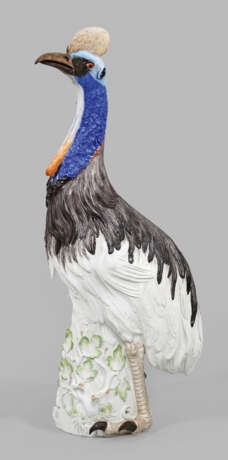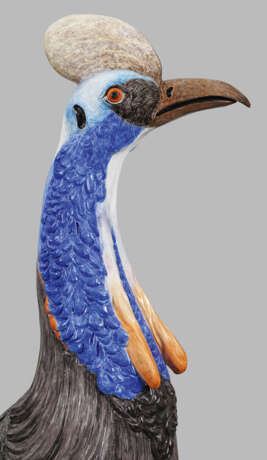ID 1082147
Lot 726 | Außergewöhnliche lebensgroße Meissen Figur eines Kasuar
Estimate value
€ 65 000 – 130 000
Außergewöhnliche lebensgroße Meissen Figur eines Kasuar Vollplastisch gearbeitete, majestätisch anmutende Figur eines Laufvogels, an einem, mit plastisch aufgelegtem Astwerk umzogenen Baumstumpf stehend, mit unbefiedertem, aufgerichtetem Hals und erhobenem Kopf, der von einem kreisförmigen Kamm bekrönt wird. Der spitz zulaufende, gebogene Schnabel ist leicht geöffnet. Äußerst naturalistische Gestaltung mit stark reliefplastischem Gefieder und akzentuierter, leuchtend farbiger Staffierung, welche die Farbenpracht des, in der Natur vorkommenden Helmkasuars andeutet. Polychrome Malerei. Entw. Johann Joachim Kaendler, 1732. Schwertermarke. H. 128 cm.
Prachtvolles Exemplar nach naturalistischem Vorbild. August der Starke zeigte ein ausgeprägtes Interesse für Zoologie. Er unterhielt Menagerien, finanzierte Expeditionen nach Afrika und trug verschiedene Vogelpräparate für seine Kunstkammer zusammen. Für die Königliche Sammlung im Japanischen Palais in Dresden gab er in den 1730er Jahren eine Reihe von Tiergroßplastiken in Auftrag. In der Menagerie studierte und skizzierte Johann Joachim Kaendler die sog. exotischen Tiere in natura. In der Nachfolge von Kirchner modellierte Kaendler detailgenau, nicht nur in Bezug auf die Wiedergabe des Äußeren seiner Tierplastik, er brachte die charakteristische Haltung und Ausdrucksweise der Tiere zur Geltung. Der Versuch, die Tiere in Lebensgröße in Porzellan umzusetzen, konnte erfolgreich unter anderem bei einigen Vogelmodellen realisiert werden, stellte nichtsdestotrotz im 18. Jh. eine große technische Herausforderung dar. In einem Bericht des Manufakturinspektors Reinhard fertigte Kaendler "den Vogel Casuarium, in Lebensgröße (...)" an. Die Inventare aus den Jahren 1770 und 1779 verzeichnen vier Ausführungen dieses Modells.
Vgl. Rückert, Kat. Bayer. Nationalmuseum, S. 189f.; Pietsch, Kat. Meißner Porzellanplastik, Nr. 222; Sponsel, Kabinettstücke des Meissner Porzellans, S. 96; Albiker, Nr. 25; Staatl. Kunstsammlungen Dresden, Inv.-Nr. PE 188.
An exceptional life-size modelled porcelain figure of a cassowary in naturalistic moulding by J. J. Kaendler, originally executed for the Royal collection of August the Strong in the Japanese palace. Crossed swords mark.
Meissen. Um 1924 - 1934.
| Address of auction |
Kunstauktionshaus Schloss Ahlden GmbH Große Str. 1 29691 Ahlden(Aller) Germany | ||||||||||||||
|---|---|---|---|---|---|---|---|---|---|---|---|---|---|---|---|
| Preview |
| ||||||||||||||
| Phone | +49 5164 80100 | ||||||||||||||
| Buyer Premium | 25.0 | ||||||||||||||
| Conditions of purchase | Conditions of purchase | ||||||||||||||
| Business hours | Business hours
|




